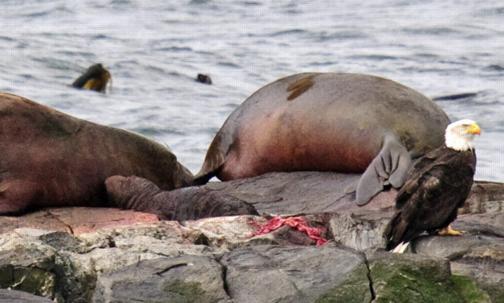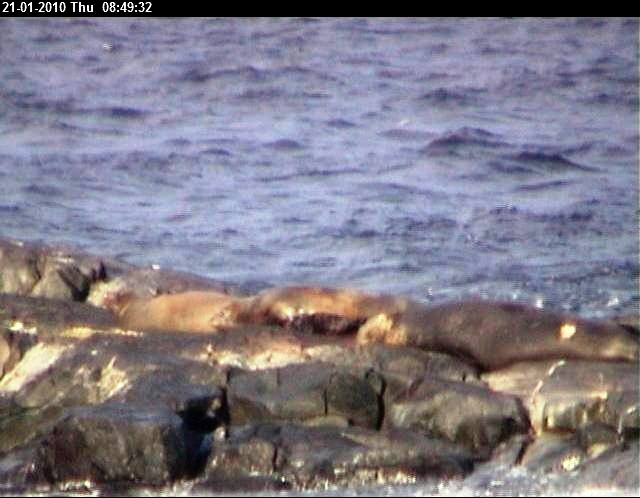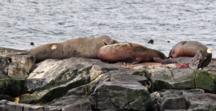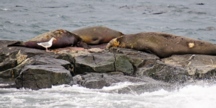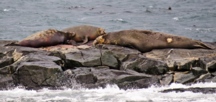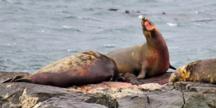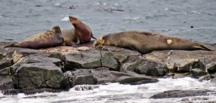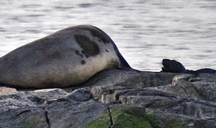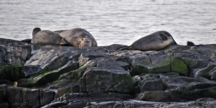The elephant seals out at Middle Rocks still with at least one pup Photos from Camera 5.
Elephant seal gives birth on Middle Island
‘Elephant Seal’, 5, ‘Camera 5 user Pam Birley first spotted our FOURTH recorded elephant seal birth here at Race Rocks. The new pup is with two adult females and Slash on Middle Rocks and so far appears to be doing well. Its mother has been discouraging eagles, gulls, and black turnstones attracted to the afterbirth.’, ‘Ryan’, ’10:31:06 ,
Elephant Seal pup on Middle Rocks, 2010
Elephant Seal pup on Middle Rocks, January 21, 2010.
|
Wounded shoulder on Northern Sea lion
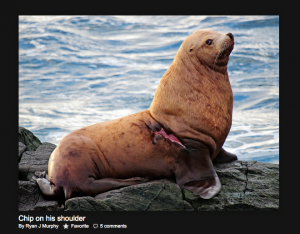 Injuries on the sea lions: Ryan recorded them with images on his Flickr site: A pretty nasty looking bite wound on this adult male. My first thought was it could have been an orca or shark, but looking at other images of similar bite wounds makes me think this was from another sea lion.
Injuries on the sea lions: Ryan recorded them with images on his Flickr site: A pretty nasty looking bite wound on this adult male. My first thought was it could have been an orca or shark, but looking at other images of similar bite wounds makes me think this was from another sea lion.
Northern Sea lions predominate
California Sea Lion’, 4, ‘Two adult males and 2 juvenile males are hauled out on the intertidal island on the SE corner of Great Race Island today. At least one adult male has been around this week.’, ‘Ryan’, ’12:19:52 ,
Northern Sea Lion’, 50, ‘Northern or Steller sea lion population has remained relatively constant this past month, with no major storms dispersing them for any amount of time. Interestingly, only 1 or 2 animals have ventured back to the largest of the Middle Rocks where the entangled sea lion was rescued. Instead, they have chosen to stay crowded on the smaller adjacent rock to the East.’, ‘Ryan’, ’12:21:57 ,
Slash and Misery conflicts
‘2010-01-17’, ‘Elephant Seal’, 4, ‘Both Slash and Misery have been hauled out on Great Race Island this past week. Misery prefers to take the higher ground to keep a strategic advantage against any of Slash ”s aggression. Misery has new bite wounds on his flank, though nothing like what Slash inflicted on him in the spring. Slash has a small cut on his nare and a small puncture wound on his hood/trunk. Pam Birley has captured and shared some photos on her flickr site which depict one of their territorial disputes in action! Both males trumpet -gurgle-burp) throughout the day, but most often at night. Neither male visibly responds to the other ”s calls. A small female has been seen frequently hauled out in the small cove formed by the gut on the South side of the island. She is much too small to mate or to climb from there up onto the rest of the island. Misery has been spending a lot of his time lounging around the Energy Centre, about 10m from the small female. Slash left here last night to join a large adult female on Middle Rock. I do not know if she is one of the three identifiable adult females who have visited Great Race Island this year, though she is the best candidate for another baby so far this season.’, ‘Ryan’, ’12:34:44 ,
Glebocarcinus oregonensis: Pygmy Rock Crab–The Race Rocks Taxonomy
Empty giant acorn shells are often the home for this small crab at Race Rocks. It was formerly called Cancer oregonensis
Scientific classification
Kingdom: Animalia
Phylum: Arthropoda
Subphylum: Crustacea
Class: Malacostraca
Order: Decapoda
Infraorder: Brachyura
Family: Cancridae
Genus: Glebocarcinus
Species: G. oregonensis
Other Members of the Phylum Arthropoda at Race Rocks.
and Image File |
 The Race Rocks taxonomy is a collaborative venture originally started with the Biology and Environmental Systems students of Lester Pearson College UWC. It now also has contributions added by Faculty, Staff, Volunteers and Observers on the remote control webcams. G. Fletcher The Race Rocks taxonomy is a collaborative venture originally started with the Biology and Environmental Systems students of Lester Pearson College UWC. It now also has contributions added by Faculty, Staff, Volunteers and Observers on the remote control webcams. G. Fletcher |
Pagurus beringanus: Bering hermit crab–The Race Rocks Taxonomy
This is a tentative identification of Pagurus Beringanus – the Bering Hermit Crab is an animal that is found from the Bering Sea to Monterrey, California. They are also found at Race Rocks. Commonly found at depths from intertidal to 365 meters.
This Pagurus is identifiable by their pale grey-blue shells (carapaces) mottled with grey, red and yellow spots. Legs are also pale blue with red bands at the joints. Claws are reddish and densely covered with spines. Bering Hermit Crabs all have characteristic green, irridescent eyes
Habitat – rocky, intertidal areas with cold water.
Behavior – Adults are inactive during the day. Starting late afternoon and carrying on through the night they become active and feed. This is because the retinal pigments in the eyes with position of the day and the night, only in response to the ambient light in the water.
Bering Hermit Crabs are scavengers, which makes the fact that they taste good puzzling. They eat dead plant materials and dead animal matter.
They themselves are prey to several types of fish, including pine perch, the California sheephead and the spotted kelpfish.
Females have been recorded with eggs mainly in April and May but some as early as February. During courtship, the male carries the female around for a day or more, knocking their shells together. The actual mating lasts less than a second, and both animals come almost completely out of their shells to perform the act.
References:
Intertidal Invertebrates of California. Morris, Abbot, Haderlie, 1980
Pacific Coast Crabs. Gregory C Jensen, 1995
Between Pacific Tides. Ricketts, Calvin, Hedgpeth, 1997
Classification:
Domain: Eukarya
Kingdom: Animalia
Phylum: Arthropoda
Class: Crustacea
Order: Decapoda
Superfamily: Paguridea
Family: Paguridea
Genus: Pagurus
Species: beringanus
Common Name: Bering Hermit Crab
Other Members of the Phylum Arthropoda at Race Rocks.
and Image File |
 The Race Rocks taxonomy is a collaborative venture originally started with the Biology and Environmental Systems students of Lester Pearson College UWC. It now also has contributions added by Faculty, Staff, Volunteers and Observers on the remote control webcams. The Race Rocks taxonomy is a collaborative venture originally started with the Biology and Environmental Systems students of Lester Pearson College UWC. It now also has contributions added by Faculty, Staff, Volunteers and Observers on the remote control webcams.Carmen Braden (PC yr 29) 2002 |
Temperature Changes Through Time
PROCEDURE:
1. Describe how this set of sea-water temperature records have been obtained. This file provides examples of the records which have been submitted to The Institute of Ocean Sciences at Sidney, Vancouver Island.
daily duties video
The students from Lester Pearson College often stay at the island and take over the daily duties such as the water sampling for temperature and salinity. This video shows the process used in the manual determination of these factors.
IOS
When the records have been submitted, they are added to a database which is maintained by the Institute of Ocean Sciences. This link shows historic sets of raw data from IOS for the British Columbia Light Stations.
2. Go to this file to obtain the Race Rocks Mean Monthly Sea Temperature 1921-present,
a) open an excel workbook and save it as “Temperature records at Race Rocks. We will copy the data for the first ten years of the record and the last ten years of the record to an empty Excel file.
b) Highlight years 1921 to 1930 from the data, copy and paste to the open Excel file.
c) Cut out each year and paste it side by side so that you have the rows representing the months and the columns representing the years. Make a horizontal table of the data
d) highlight across the able, the temperatures for each month of the ten year group. Then click on the symbol in the menu line which produces an average. This average will appear to the right of the last years column.
e) Do the same with the last ten years set of data. You now have two sets of averages by month of the two decades.
f) Compare the monthly averages for the two decades. What do you find?
3. There are of course many ways of looking at this data. Try summing the total averages for each decade. Simply highlight the column of averages and click on the tool for SUM. What is your finding.
4. You could also do the same for all the decades.Once you have a chart made up of the monthly averages of all the decades, It is easy to have Excel draw a graph for you. Click on the Wizard symbol and choose the type of graph.
5. After manipulating the data, and looking at it in several ways, write a statement which expresses your understanding of the whether or not there has been a temperature change in the Strait of Juan de Fuca as measured by daily samples taken at Race Rocks. Be sure that you do not generalize beyond the evidence provided by your data. Also discuss the assumptions that you must recognize before drawing a conclusion from this data.
6. For Extension work: Run a statistical program to determine if the difference you find is significant.
7. For Extension work: Read the review below and if possible, read the book! Present a summary to your class.
The long-term Sea temperature record at Race Rocks has been pointed out as one of the pieces of evidence that has accumulated on global warming. Author Terry Glavin, in reviewing the book The Weather Makers by Tim Flannery ( Harper Collins Publishers, 2006) says :
” The Pacific Ocean itself is getting warmer. Measurements at the Race Rocks lighthouse near Victoria show an average rise in temperature of 1°C since 1921, which doesn’t sound like much until you remember that its only 10°C in the other direction that separates us from the deep freeze of the Ice Age. The ocean, absorbing increasing volumes of carbon dioxide, is becoming more acidic, too, inhibiting the production of plankton, the basis of all life in the sea.”
The rest of the article may be seen at http://www.straight.com/content.cfm?id=17132
8. Refer to the file: Sea Temperature as an abiotic factor .
castSeveral ideas are discussed in this file about how the sea water temperature affects marine organisms. Discuss how organisms adapt to changes in sea temperature.
9. Extension: Find out the monthly water temperature averages from your own area. Compare them with Race Rocks and discuss the geoclimatic factors which lead to the similarities and or the differences, and the implications for organisms living in the two ecosystems.
Pigeon Guillemots back
-45, ‘2010-01-09’, ‘Other’, 18, ‘Pigeon guillemots still in their winter plumage were foraging in front of the jetty this morning. I believe this is about 10 days earlier than they were first spotted last year. I have been more conscious of their presence in Race Passage and Pedder Bay this winter as well.’, ‘Ryan’, ’10:49:29 ,


